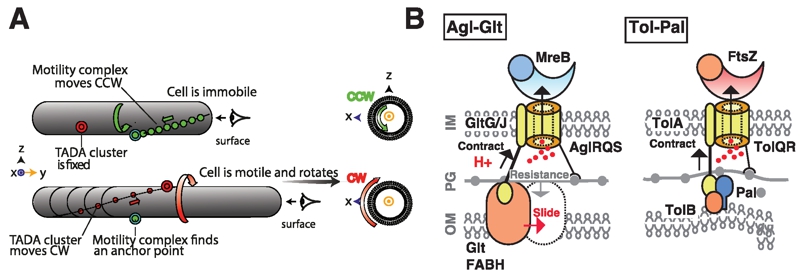Back to article: New insights into the function of a versatile class of membrane molecular motors from studies of Myxococcus xanthus surface (gliding) motility
FIGURE 1:
(A) The helical movement of intracellular motors drives rotational movement of the cell. Intracellular counter-clockwise (CCW)- motor complexes (green) propel the cell in a screw-like clockwise direction when they become tethered at so-called FAs. (CW, shown by trajectory of a fixed point at the cell surface in red. The CCW or CW directionality is determined by the position of the observer (eye symbol). Adapted from Faure et al, 2016 with permission.
(B) Core structure and function of the Tol/Exb/Agl class of molecular motors. The Agl-Glt and Tol-Pal systems are shown side-by-side for comparison. The structure of the Agl-Glt machinery is simplified to its core Tol-like components for clarity. In both cases, the proton flow through a PG-bound TolQR-type channel (yellow) is believed to energize cyclic interactions between a flexible IM-anchored periplasmic TonBC domain protein (black-yellow) and TonB-box proteins in the OM (orange). In the case of Agl-Glt, combined with the rigid anchoring to PG (grey arrow), this activity would push the OM protein laterally (red arrow), propelling the cell. In Tol-Pal, similar dynamics would provoke OM invagination and participate in cytokinesis. Interestingly, both Tol-Pal and Agl-Glt are physically connected to cytoskeletal proteins, FtsZ and MreB respectively. Adapted from Faure et al, 2016 with permission.

